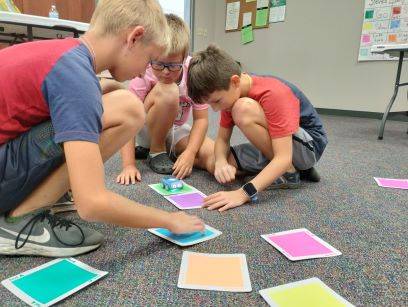Coding with Steve
Screenless coding with Steve
Grade: 1-4 (limit 32 students)
Time: 45-60 minutes

Students get to learn Steve’s language through color coded tiles, using sequential thinking to accomplish tasks with Steve. The class will break into small groups to learn about their robot and complete obstacle courses. In our experience, ideal small group size is 3 students per robot to a max of 4 students. The first lesson will cover the basics of Steve and his friends; which color tiles signal which commands, rules when handling the robots, etc. The second lesson will be focused on a very simple obstacle course (tailored to the grade). Finally, the last lesson will be a more advanced obstacle course or challenge, again tailored to the grade and how far the students were able to progress through the previous sessions. This lesson is presented by Sedgwick County 4-H department staff and master educator volunteers.
Availability: 2 week advance notice is required to schedule this lesson. Requests for this lesson are scheduled on a first come, first served basis and depend on the availability of our staff.
Teacher Provides:
- Divide students into small groups that will work well together.
- Large flat indoor space. Min. of 25 sq feet (gym floor or cleared area in classroom)
- One adult volunteer for every 4-8 children is recommended.Youngergrades would benefit from a 1:4 ratio whereashigher grades may only need a 1:8 ratio.
First grade Standards:
- 1.MP.2 Reason abstractly and quantitatively.
- 1.MP.5 Use appropriate tools strategically.
- 1.MD.A.1 Order three objects by length; compare the lengths of two objects indirectly by using a third object.
- 1.SL.1.1 Participate in collaborative conversations with diverse partners about grade 1 topics and texts with peers and adults in small and larger groups.
- 1.ETS1.A: Defining and Delimiting Engineering Problems
- A situation that people want to change or create can be approached as a problem to be solved through engineering. (K-2-ETS1-1)
- Asking questions, making observations, and gathering information are helpful in thinking about problems. (K-2-ETS1-1)
- Before beginning to design a solution, it is important to clearly understand the problem. (K-2-ETS1-1)
- 1.ETS1.B: Developing Possible Solutions
- Designs can be conveyed through sketches, drawings, or physical models. These representations are useful in communicating ideas for a problem’s solutions to other people. (K-2-ETS1-2)
- 1.ETS1.C: Optimizing the Design Solution
- Because there is always more than one possible solution to a problem, it is useful to compare and test designs. (K-2-ETS1-3)
Second grade Standards:
- 2.W.2.8 Recall information from experiences or gather information from provided sources to answer a question.
- 2-PS1-2. Analyze data obtained from testing different materials to determine which materials have the properties that are best suited for an intended purpose.
- 2.MP.2 Reason abstractly and quantitatively.
- 2.MP.4 Model with mathematics.
- 2.MP.5 Use appropriate tools strategically.
- 2.MD.3. Estimate lengths using whole units of inches, feet, centimeters, and meters.
- 2.ETS1.A: Defining and Delimiting Engineering Problems
- A situation that people want to change or create can be approached as a problem to be solved through engineering. (K-2-ETS1-1)
- Asking questions, making observations, and gathering information are helpful in thinking about problems. (K-2-ETS1-1)
- Before beginning to design a solution, it is important to clearly understand the problem. (K-2-ETS1-1)
- 2.ETS1.B: Developing Possible Solutions
- Designs can be conveyed through sketches, drawings, or physical models. These representations are useful in communicating ideas for a problem’s solutions to other people. (K-2-ETS1-2)
- 2.ETS1.C: Optimizing the Design Solution
- Because there is always more than one possible solution to a problem, it is useful to compare and test designs. (K-2-ETS1-3)
Third grade Standards:
- 3.MP.2 Reason abstractly and quantitatively.
- 3.MP.5 Use appropriate tools strategically.
- 3.MP.4 Model with mathematics.
- 3.W.3.7 Conduct short research projects that build knowledge about a topic.
- 3-PS2-2. Make observations and/or measurements of an object’s motion to provide evidence that a pattern can be used to predict future motion.
Fourth grade Standards:
- 4-PS4-3. Generate and compare multiple solutions that use patterns to transfer information.
- 4.MP.2 Reason abstractly and quantitatively.
- 4.MP.4 Model with mathematics.
- 4.MP.5 Use appropriate tools strategically.
- 4.W.4.7 Conduct short research projects that build knowledge through investigation of different aspects of a topic.
- 4.W.4.8 Recall relevant information from experiences or gather relevant information from print and digital sources; take notes and categorize information and provide a list of sources.
- 4.ETS1.A: Defining Engineering Problems
- Possible solutions to a problem are limited by available materials and resources (constraints). The success of a designed solution is determined by considering the desired features of a solution (criteria). Different proposals for solutions can be compared on the basis of how well each one meets the specified criteria for success or how well each takes the constraints into account. (Secondary to 4-PS3-4)
- 4.ETS1.C: Optimizing the Design Solution
- Different solutions need to be tested in order to determine which of them best solves the problem, given the criteria and the constraints. (Secondary to 4-PS4-3)

